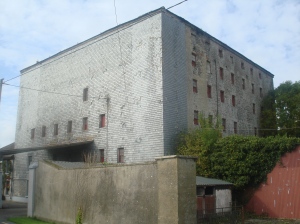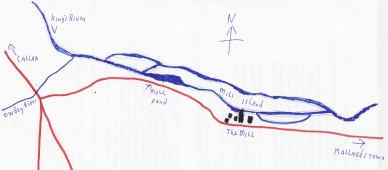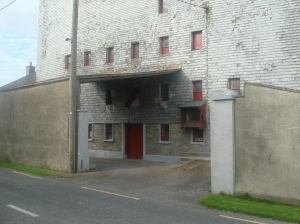Mill Island mill in Mallardstown parish, Co. Kilkenny
Niall C.E.J. O’Brien
Today in the townland of Mill Island, beside the King’s River, in the civil parish of Mallardstown, Co. Kilkenny stands the former flour and corn mill of olden days. The seven-bay six-storey flour mill is built upon a L-shaped plan with five-bay six-storey North-South elevations and two-bay six-storey side elevations.[1] This article is a brief snap shot on the history of the mill.

South and east side of the main mill building
The area around Callan and Kells and onto Gowran and Goresbridge has good fertile soils for grain growing. A journey through the landscape on an August day would be full of golden fields of ripe grain. Consequently the area is dotting with old and new grain mills. It is not known when the mill at Mill Island was first built. In the 1760s the land between the King’s River and the River Nore was one of the cradles of the Irish flour milling industry and the mill of Mill Island could be attributed to that time.[2] Some sources say the mill was built about 1790-1810.[3] Of course the site may be the location of an older mill, possibly a medieval mill, but the absence of documents may it difficult to know for sure.
Lewis Topographical Dictionary of Ireland, 1837
The work of Samuel Lewis, A Topographical Dictionary of Ireland, said in reference to the parish of Mallardstown that William Phelan worked an extensive flour mill in the parish at Mill Island.[4]
1841 Ordnance Survey map
The six inch Ordnance Survey map for 1841 shows the flour mill in the townland of Mill Island as on the south side of the King’s River. Upstream was a mill pond. The King’s River was divided to the west of the mill with the mill pond feeding the mill and the north course of the river passing round by the north and so creating an island on the north side opposite the mill. The two branches later re-joined each other below the mill.
A general map showing the mill site and the different waterways
1841 census
The townland of Mill Island in 1841 had a population of eight people made up of five males and three females. These people lived in two dwelling houses while a third dwelling house was uninhabited.[5]
Griffith’s Valuation
At the time of Griffith’s Valuation (c.1850), William Phelan rented the entire area of the townland of Mill Island, containing 24 acres 3 roots and 26 perches, from Robert B. Bryan. The land was worth £17. But the most important property in the townland was the house, offices and flour mill that William Phelan also rented. These buildings were valued at £90.[6]
The Bryan family owned a number of properties in the general Mallardstown area apart from the Mill Island townland.
Mill details
The flour mill was powered by a water wheel that measured 18 feet (wheel diameter) X 8 feet (breadth) X 4 feet (fall of the water) according to the Valuation Office Mill Books.[7] Although the mill is now no longer in use most of the fixtures and fittings are still in pace.
A notable feature of the mill is the slate-hung wall on the south elevation which give the building an imposing presence on the landscape.
1851 census
In the 1851 census the townland of Mill Island had a population of six people, one male and five females. These people lived in one dwelling house. Another dwelling house in the townland was uninhabited. The Poor Law Valuation in 1851 was £75 which is a reduction from that of Griffith’s Valuation.[8] It would seem that some buildings were removed. This seems to be bared out by the fact that in 1841 there were three dwellings houses in the Mill Island townland.
1874
In 1874 William B. Bryan was the miller at the mill which was then owned by William Bryan and James Fitzgerald.[9] None of these people appear in the 1876 list of owners of one acre and upwards which would suggest that the actual owner of the mill was somebody else and that William Bryan and James Fitzgerald had a long lease on the property.
1891 census
In the 1891 census there were four people living in the townland of Mill Island in one dwelling house.[10]
1901 census
By the time of the 1901 census the flour mill at Mill Island had become a corn mill and was marked as such on the Ordnance Survey map. The mill operator was Thomas Fitzgerald (aged 38). Thomas Fitzgerald lived by the mill where he gave his occupation as a corn merchant, miller and farmer. Outside of work Thomas Fitzgerald was a Kilkenny County Councillor, District Councillor and Poor Law Guardian.[11]
In 1896 Thomas Fitzgerald appears as an elector in the Callan district with an address at Mill Island. There was another Thomas Fitzgerald as an elector in the Mallardstown Great townland.[12]
Farming buildings surround the mill
In the early maps the mill stands on its own ground surround by associated buildings. By 1901 some of these buildings were converted into agricultural use while new buildings were added on. In 1901 there were surrounding the mill two stables, one coach house, one cow house, one piggery, two fowl houses and one turf house.[13]
Local miller’s in the Callan area in c.1901 and 1911
The 1901 census records the names and addresses of some people in the wider surrounding are of the mill of Mill Island who were engaged in the milling and corn trade. William Fitzgerald (aged 18) of Baunta Commons in the Callan Rural D.E.D. Co. Kilkenny gave his occupation as a miller. Ellen Lanigan (aged 30) of Green Street in Callan was a milliner. Also in Green Street, Callan, was Ellen Sheely (aged 22) another milliner. In the same 1901 census Mary A. Dunphy (aged 19) of Bridge Street Lower in Callan Urban was a milliner.
Outside of Callan town and near the mill of Mill Island lived James Cody (aged 42) of Brimeen alias Drimeen, in the Callan Rural D.E.D. who in 1901 was a miller. Also in the 1901 census was Michael Cantwell (aged 40) of Mallardstown in the Callan Rural D.E.D. was a miller. These people may have worked at the Mill Island mill.
Back in Callan town, in 1901, John Maher (aged 27) of Green Street was a corn buyer.
The front door so to speak of the mill building
Thomas Fitzgerald and the Bryan family
As well as having the mill site and townland Thomas Fitzgerald also rented other lands in the Mallardstown area. But he fell on hard times and was not able to keep up the payments. In 1904 the Trustees of Butler Bryan evicted Thomas Fitzgerald from 38 acres of land at Mallardstown. The annual rent for these 38 acres was £115 at the time of the eviction.
But with the help of the Estate Commission Thomas Fitzgerald was able to purchase part of the holding and the mill site with an annuity payment of £28 6s 2d on a total land area of 39 acres no root and 39 perches.[14]
1911 census
In 1901 Thomas Fitzgerald was unmarried. About 1909 he married a woman called Eleanor Fitzgerald from Co. Tipperary and had two children, Katherine and James. Shortly before the 1911 census Thomas Fitzgerald died leaving Eleanor a widow.[15]
In the 1911 census Eleanor Fitzgerald held the mill with the following outhouses; two stables, one coach house, one dairy, one piggery, one fowl house, one barn house, one turf house and two sheds.[16] The Poor Law Valution of Mill Island townland in 1911 was £58 10s.[17]
The mill by 1963
In 1963 Somers Brothers held the mill and they were licence to mill wheaten meal up to 1,000 barrels.[18]
Today (2015)
Today (2015) the six story mill building of Mill Island stands among other buildings great and small by the road from Callan to Mallardstown. This article is but a brief snap shot of the history of the mill.
===========
End of post
============
[1] http://www.buildingsofireland.ie/niah/search.jsp?type=record&county=KK®no=12402607
[2] L.M. Cullen, ‘The Social and Economic Evolution of Kilkenny in the seventeenth & eighteenth centuries’, in Kilkenny History and Society, edited by William Nolan & Kevin Whelan (Geography Publications, Dublin, 1990), p. 277
[3] http://www.buildingsofireland.ie/niah/search.jsp?type=record&county=KK®no=12402607
[4] Samuel Lewis, A Topographical Dictionary of Ireland (2 vols. Samuel Lewis, London, 1837), vol. 2, p. 338
[5] http://www.dippam.ac.uk/eppi/documents/13110/page/335562
[6] Griffith’s Valuation, County Kilkenny, Barony of Kells, Parish of Mallardstown, townland of Mill Island
[7] William E. Hogg, The Millers and Mills of Ireland (2011), Kilkenny county, Mallardstown parish, Mill Island townland
[8] http://www.dippam.ac.uk/eppi/documents/13110/page/335562
[9] William E. Hogg, The Millers and Mills of Ireland (2011), Kilkenny county, Mallardstown parish, Mill Island townland with reference to Registry of Deeds 1874 15 147
[10] http://www.dippam.ac.uk/eppi/documents/21959/page/614338
[11] http://www.census.nationalarchives.ie/pages/1901/Kilkenny/Callan_Rural/Mill_Island/1444688/
[12] http://www.igp-web.com/IGPArchives/ire/kilkenny/xmisc/callan-elec-1896.txt
[13] http://www.census.nationalarchives.ie/reels/nai000915551/
[14] http://www.dippam.ac.uk/eppi/documents/21623/page/606481
[15] http://www.census.nationalarchives.ie/pages/1911/Kilkenny/Callan_Rural/Millisland/562182/
[16] http://www.census.nationalarchives.ie/reels/nai002621906/
[17] http://www.dippam.ac.uk/eppi/documents/21959/page/614338
[18] http://oireachtasdebates.oireachtas.ie/debates%20authoring/debateswebpack.nsf/takes/dail1963103000027?opendocument


Lovely story keep up good work nice to be able to do up the mill
Thanks Ginlisa
Great read thanks for this I’m trying to get as much history of mallardstown and the surrounding area as possible because my grandmother was from around the area
Thanks Anthony,
Glad to be of some help.
Niall